| Botanical Name |
|
| Family |
Asteraceae - The daisy family. |
| Pronunciation |
brak-ee-LAY-nuh ee-LIP-ti-kuh |
| Common Name(s) |
English: Bitter-leaf silver-oak
Afrikaans: Bitterblaar; Suurbos
IsiXhosa: isiduli; isagqeba
|
| Plant Group |
- Tree A woody, self-supporting perennial plant usually with a single main stem and generally growing more than 6 meters tall.
|
| Plant Size |
- Small
| Tree | 4m to 8m |
| Shrub | 50cm to 75cm |
| Perennial/ground cover | 10cm to 20cm |
| Bulb | 20cm to 30cm |
| Succulent | 10cm to 20cm |
- Very Small
| Tree | 3m to 4m |
| Shrub | 25cm to 50cm |
| Perennial/ground cover | Up to 10cm |
| Bulb | 10cm to 20cm |
| Succulent | Up to 5cm |
|
| Position |
- Canopy Shade Canopy shade is found below closely grown trees where some light filters through. Ideal for the protection of herbaceous plants.
- Dry Shade Shady areas where soil has poor water retention or are dependent on rain for their moisture needs.
- Light or Dappled Shade Found below trees with sparse, open foliage. Ideal for the protection of herbaceous plants.
- Partial Shade The area is in shade for part of the day and in full sun for part of the day.
- Sun The area is in full sun for all or most of the day, all year round.
|
| General Information |
- Drought Tolerance: High The plant is well adapted to arid conditions; it can survive long periods of drought and high temperatures without extra water.
- Evergreen Plants that have leaves all year round.
- Frost: Hardy The plant can withstand freezing temperatures or frost without artificial protection.
- Roots Non-invasive Safe to plant near pools, paving, walls or buildings.
- Salt spray tolerant A plant with specific adaptations enabling it to grow in a saline environment.
- Sand tolerant Plants adapted to survive in nutrient poor, very sandy soils.
- Water Wise Plant species originating from low rainfall regions that require less water to survive and thrive than other plant species.
- Wind Tolerant Plants able to withstand the effect of strong winds.
|
| Specific Information |
The interesting, angular foliage is glossy dark-green above and silvery-white underneath. Brachylaena elliptica can be grown as a large shrub if trimmed to size, as it tolerates pruning.
|
| Ad Break |
|
| Flowers |
| Description |
small thistle-like blooms in large sprays
|
| Season |
- Autumn to Winter Plants will seldom bloom for the entire season as given in the list, but should flower during a period within these parameters.
|
| Colour |
|
| Growth Rate |
- Moderate to Fast Specifying growth rate can be very misleading as there is considerable variation of growth rate depending on type and species of plant, available water, supplementary feeding, mulching and general care, as well as the plants suitability and adaptability to the garden environment.
|
| Plant Uses |
- Attracts bees, butterflies or other insects This plant attracts insects which can be food for birds or other creatures in your garden.
- Attracts Birds This plant will attract birds.
- Boundary A plant useful for planting around the edges of the property to form a green or colourful backdrop, an impenetrable hedge, to hide walls or create privacy.
- Container Trees, shrubs and ornamental species that can adapt to growing in a restricted environment.
- Filler Either a fast growing tree or shrub used temporarily to fill in an area while the permanent plants grow to a desired size, or a plant used to fill gaps in borders or beds.
- Foliage Plant Plants grown because their foliage is colorful or unique. Many of these plants have insignificant flowers.
- Hedge Suitable trees or shrubs planted relatively close together so that the branches intertwine to create a barrier. This can be formal – the plants are regularly trimmed to produce a neat shape, or informal – the plants are left to themselves to create a natural hedgerow.
- Pioneer for new gardens A very fast growing plant, able to withstand hardship, that can be used to populate land that has recently been cleared of natural vegetation. These plants pave the way for slower-growing species by adding nutrients to the soil and creating leaf litter.
- Provides light / dappled shade A tree with an open to sparse canopy, through which varying degrees of sunlight can penetrate.
- Screen A tall hedge of suitable plants planted closely together and used as a windbreak, to block a bad view, to separate parts of the garden or as a backdrop.
- Stabilize Banks Plant is used to prevent soil erosion because their roots will form a mat that stabilizes the soil and keeps it from washing away in heavy rains.
- Suitable for coastal gardens Plants adapted to dry, sandy soil, forceful wind, limited rainfall and intense sunlight.
- Suitable for seaside gardens Plants that will survive the hostile environment of harsh salty winds, dry sandy soil, irregular rainfall and heat found in seaside gardens.
- Suitable for smaller gardens Such plants do not have invasive root systems, remain small or controllable and can often be grown in containers.
- Wild Garden An indigenous garden planted for the benefit of wildlife and birds. Provides food, water, a variety of mini-biomes and no poisonous chemicals are used.
- Windbreak Trees planted in a row to form protection from prevailing winds by breaking the force of the wind, thereby reducing wind damage.
|
| Distribution and Habitat |
in the Eastern Cape Province from Port Elizabeth to Durban in KwaZulu-Natal, in coastal and river bush, valley thicket, scrub-land, on rocky outcrops and along the edges of evergreen forest
|
| Planting Suggestions |
|
| Medicinal Uses |
Poles from this species are used as fence posts. The sticks have been used to start a fire by friction. The leaves are believed to be used as a treatment for diabetes and infused, are used as a gargle and mouthwash.
|
| Ad Break |
|


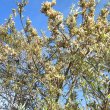
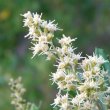
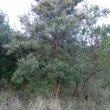
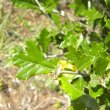
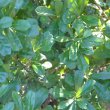
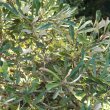
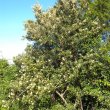
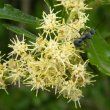


Discuss this plant
Share knowledge, ask a question or give an experience.